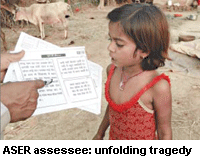The Annual Status of Education Report (ASER) 2011 — a nationwide survey of learning outcomes in (mainly government) rural primary (classes I-VIII) schools in 16,017 sample villages in 558 of India’s total 640 districts which tested 633,465 children — confirms the worst fears of committed educationists that very little actual learning happens in the country’s 1.25 million primary schools.
The only silver lining of the sixth ASER study, unembarassedly released by Union human resource development minister Kapil Sibal in Delhi on January 16, is that 96.7 percent of all six-14-year- olds in rural India are enroled in government, aided and unaided private primaries and upper primaries. But the rest is all bad news.
 “The first news in 2012 based on ASER 2011 is that private school enrolment in most states is increasing although the Right to Education Act for free and compulsory education is in place. Over 25 percent of rural India’s children go to private schools and the numbers will rise in coming years as education and wealth increase… The second piece of news is that not only are India’s learning levels very poor on an inter-national absolute scale, the levels in government schools in the North have steadily declined with the exception of Punjab and Himachal Pradesh. The decline is quite alarming,” says Madhav Chavan, the promoter-chief executive of Pratham (estb.1994) which sent out over 25,000 volunteer field researchers (mainly college and university students) to conduct this mammoth and valuable survey.
“The first news in 2012 based on ASER 2011 is that private school enrolment in most states is increasing although the Right to Education Act for free and compulsory education is in place. Over 25 percent of rural India’s children go to private schools and the numbers will rise in coming years as education and wealth increase… The second piece of news is that not only are India’s learning levels very poor on an inter-national absolute scale, the levels in government schools in the North have steadily declined with the exception of Punjab and Himachal Pradesh. The decline is quite alarming,” says Madhav Chavan, the promoter-chief executive of Pratham (estb.1994) which sent out over 25,000 volunteer field researchers (mainly college and university students) to conduct this mammoth and valuable survey.
It’s hardly surprising that Chavan, a former professor of physics at Mumbai University who dropped out of acad-emia to promote and nurture Pratham into India’s largest education NGO which provides remedial education to 3 million children in 17 states country-wide, is alarmed. ASER 2011 reveals that in most of the 29 states and five territories of the Indian Union, the learning outcomes of primary school children are three years behind the expected level. Only 48.2 percent of class V students can read and understand class II texts (as opposed to 53.7 percent in 2010). In numeracy as well, primary learning outcomes are plunging. In 2010, 70.9 percent of class V students could solve a two-digit subtraction problem; now the national average is 61 percent.
This steady decline in primary learning outcomes is coincident with the allocation of funds for the Sarva Shiksha Abhiyan (SSA) or primary education for all programme having steadily risen from Rs.7,166 crore in fiscal 2005-06 to Rs.21,000 crore in 2010-11. Despite this clear indication that there is no correlation between funding and plunging learning outcomes, Sibal believes the panacea is to more than double the Centre and state govern-ments’ combined annual expenditure on education from the current 3.8 percent of GDP. “We need to invest much more in education. As a matter of fact, many developed nations invest 9-10 percent of their GDP on education,” said Sibal in an interview to the Times of India (January 22).
Instead of outlining what plans, if any, the HRD ministry has to improve infrastructure, tackle chronic teacher truancy and raise learning outcomes in the 1.26 million government primary-secondaries countrywide which is forcing even the poorest households to sign up their children in private fees-levying schools, Sibal has typically chosen the softer option. As per UNDP’s Human Development Report 2011, the People’s Republic of China allocates a mere 2.5 percent of its annual GDP for education. Despite this, it has attained 95.9 percent literacy (cf. India’s 65 percent) and 7.5 mean years of schooling (4.4).
According to Lant Pritchett, professor of the practice of international development at the Harvard Kennedy School and a member of the ASER Centre’s advisory board, that three out of four children don’t learn enough to cross a low threshold at the end of every year — as indicated by class V children unable to read class II texts — is “the most stark and striking” revelation of ASER 2011. “The result is that you could easily be one in one of the three children who complete lower primary schooling passed through five entire years of schooling, having spent 5,000 hours in school, still lacking the most fundamental skills. And so, year after year, a dream deferred becomes a dream denied,” writes Pritchett in the foreword of ASER 2011.
Yet in Shastri Bhavan, New Delhi which houses the top brass of the Union HRD ministry and in the somnolent education ministries of state governments, there seems minimal awareness of this unfolding mass tragedy. Within them it’s business — and politicking — as usual.
Dilip Thakore (Delhi)